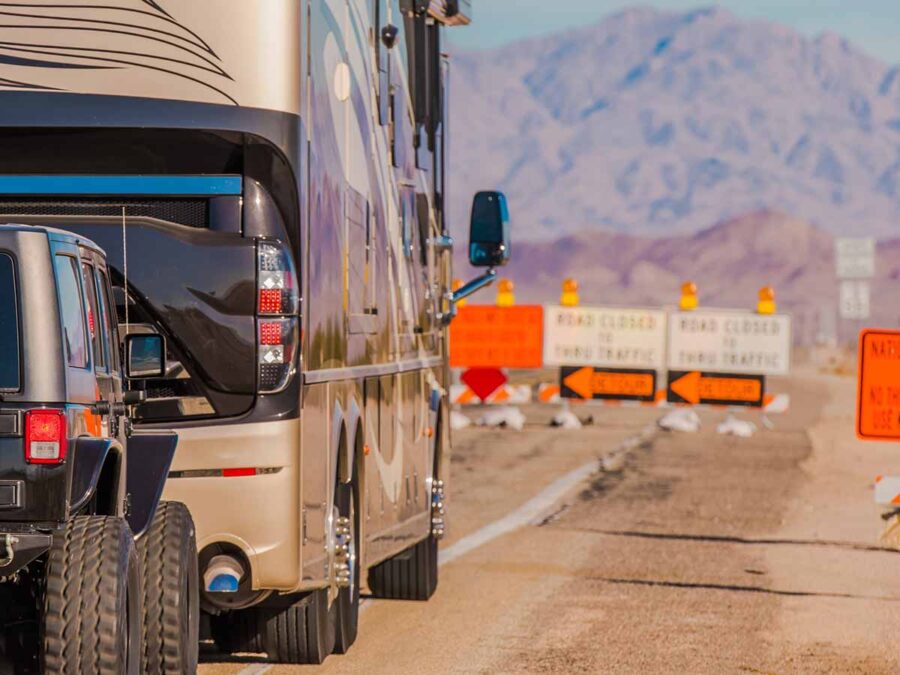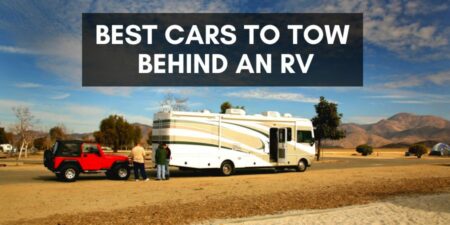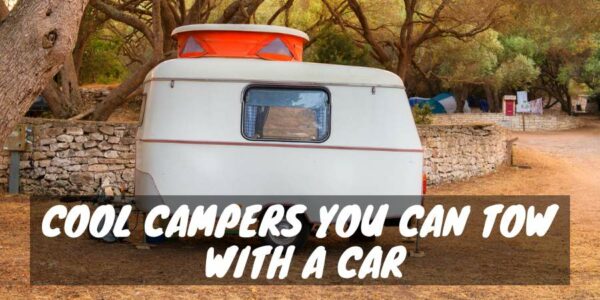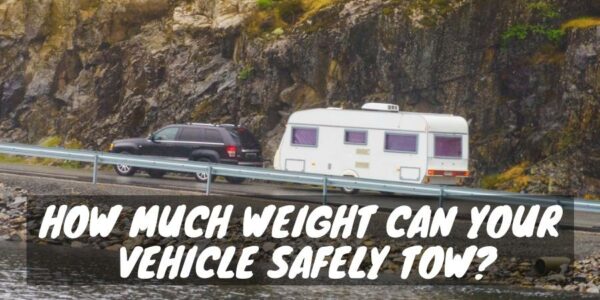Traveling in a motorhome can create problems when you reach your camping destination and want to visit all the local sites. Renting a car, hiring Uber or Lyft drivers, arranging shuttles, or continually breaking camp to drive your RV is a hassle and can get expensive.
The solution to this dilemma is to learn how to tow a car behind an RV like your Class A motorcoach, Class C motorhome, or Class B campervan. Having a car to drive while camping in a motorhome is convenient and gives you more freedom to experience attractions and activities.
Pulling a “toad” or “dinghy” behind a motorhome is common, and we explain all the ways to do so right here. So, if towing sounds like something that interests you, this guide will help you pick the best way to pull a car behind an RV so it arrives safely.
Necessary Equipment for Towing a Car behind an RV
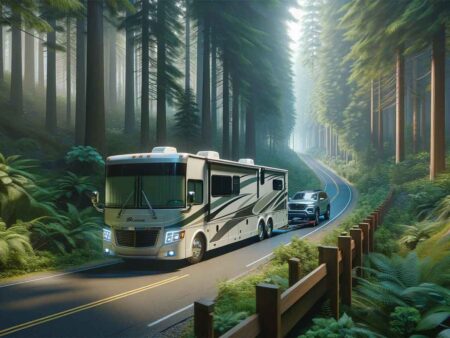
There are several ways to pull a car behind an RV, and which one you choose depends on several factors, such as:
- If the car is front or rear-wheel drive
- How far or fast you are towing the vehicle
- How much wear and tear do you wish to put on the car
- The towing capacity and hitch rating of your motorhome
Most motorhomes come with a rear hitch and a towing capacity rating, so you can use a car dolly or pull a trailer or boat along on camping trips.
If you wish to tow a car behind an RV, you’ll need to read the motorhome’s owner’s manual to see if you can add a trailer hitch and learn how much weight the RV can safely pull. Not all RV framing and engines can handle the extra stress of towing a vehicle, leading to expensive repairs or deadly accidents if you don’t follow the manufacturer’s guidelines.
What Is A Motorhome Trailer Hitch?
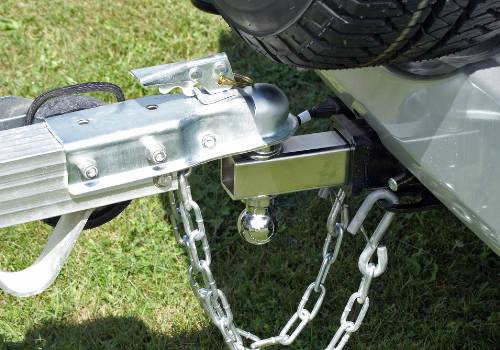
A motorhome trailer hitch is a metal component that is welded or bolted to the rear of the chassis. The “receiver” part of the hitch is a square tube with either a 1-1/4″, 2″, 2-1/2″, or 3″ inside diameter and can handle a specific maximum gross trailer weight (GTW).
Ratings for these hitch sizes are:
Class 1 Hitch: 1-1/4″ receiver – up to 2,000 pounds GTW
Class 2 Hitch: 1-1/4″ receiver – up to 3,500 pounds GTW
Class 3 Hitch: 2″ receiver – up to 8,000 pounds GTW
Class 4 Hitch: 2″ receiver – up to 10,000 pounds GTW
Class 5 Hitch: 2″ – 2-1/2″ receiver – up to 20,000 pounds GTW
The most common type of RV hitch includes the square receiver with a square metal post with a round piece on top, called a ball hitch. The two parts slip together and lock in place using a pin. The trailer or tow dolly will have a tongue that locks in place over the ball hitch so you can pull it down the road.
Every hitch has a GTW, and you must take this into consideration, along with the towing capacity of your motorhome, before selecting which car and towing trailer option is best for your needs.
As for motorhome towing capacity, here are the average weight different RVs can tow:
- Class A: 10,000 pounds
- Class B: 5,000 pounds
- Class C: 5,000-10,000 pounds
Some large motorcoaches can tow upwards of 15,000 pounds, but towing capacity will vary between brands and models, so always check the limits if you plan to tow a vehicle or trailer behind your RV.
What Is A Trailer Harness?
Whenever you tow a car or trailer behind your RV, you must provide electrical power so running lights, tail lights, brake lights, and turn signals operate at the rear to avoid traffic accidents. Many trailers also have an electric brake system, which requires power to function.
A trailer harness is a bundle of wires that plug into the rear of your RV near the hitch receiver and run to the various lights and components on the trailer or tow dolly, or they are loose, and you hook them to the rear of the car you are towing.
All states require proper lighting on any towed vehicle or trailer, so wiring is essential. Most trailer electrical harnesses come with six or seven wires or “pins” to make a quick connection to your motorhome.
The Best Way To Pull A Car Behind An RV
Now that we detail the basics of hooking up a car to the back of your motorhome let’s move on to how you can tow a vehicle.
Four Down
The first way you can tow a car is “four down,” which is pulling a car with all four wheels on the road.
Many people call this style “flat towing,” but not all car transmissions are made for this. The owner’s manual for your vehicle should indicate if four down towing is safe and detail the correct steps to engage the car when doing so.
The benefits of the four-down towing method are the less expensive, compact tow bar that is easy to store at the campsite and a more stable feeling while towing.
The biggest negative to this towing style is that you cannot back up the RV while the car is attached. This issue means planning your trip and stops at gas stations or other tight locations is crucial to avoid the need to unhook the car just to maneuver.
Legally, most states require a flat-towed car to have a supplemental braking system, such as the Blue Ox BRK2019 Patriot 3, which adds to this towing option’s overall expense.
The basic supplies for four down towing behind an RV include:
- Tow bar
- A base plate kit was installed on the front of the toad
- Wiring harness kit
- Safety cables or chains
- Braking kit
If you’re unsure how to install these towing components, hire a professional to avoid damage to your RV or toad and avoid accidents while traveling.
We suggest looking at the Roadmaster Nighthawk towbar kit for flat towing behind your motorhome, which offers superior-quality design, construction, and materials.
Tow Dolly
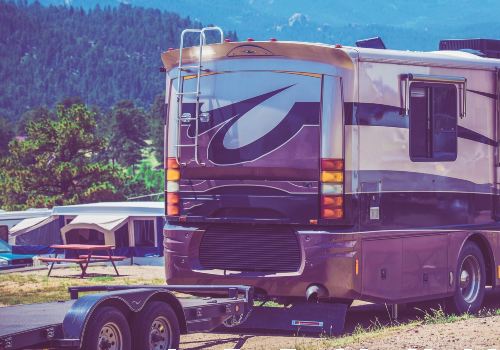
Using a tow dolly is another common way people pull a car along on RV trips when driving a motorhome.
A tow dolly is a short trailer with two wheels that carries the front two wheels of the car while the rear two wheels remain on the road. The rear wheels will roll along with the movement of the motorhome.
A tow dolly is the top choice for cars with front-wheel drive transmissions. However, you can use them for rear-wheel-drive vehicles if you can disconnect the transmission during use.
A tow dolly is relatively small compared to a full-size car hauler trailer, so it’s a bit easier to tuck it away on your campsite when not in use. However, a quality tow dolly isn’t cheap, with an average price of around $2,750.
Like the four-down towing method, using a tow dolly does not allow you to back up the motorhome while attached. Another thing to note is that most states will require you to maintain a valid license plate for the dolly.
The basic tow dolly supplies include:
- Ball hitch
- Ratchet straps
- Safety chains
- Braking kit (if not part of the dolly)
We suggest you look at the Demco 9713047 Tow Dolly and the Roadmaster Universal Tow Dolly that get top ratings from RVers.
Car Hauler Trailer
Pulling a full-size flat-bed trailer behind your motorhome is your only option if you have an all-wheel-drive car or a 4-wheel-drive vehicle.
A flat trailer or car hauler will have two axles, low sides, and retractable ramps so you can drive the car on and off at the campsite or your home. A car hauler needs to fit the length of your vehicle and support the weight.
A car hauler trailer should have a minimum rating of 3,500 pounds for each axle. The trailer should also include electric brakes for better control and safety while towing.
In many instances, the total weight of the car hauler trailer and the vehicle you wish to tow will exceed the motorhome’s towing capacity or hitch rating. So, keep the total weight in mind when planning camping trips so you can purchase the appropriate RV and hitch system.
The basic supplies for car hauler towing behind an RV include:
- Ratchet straps and safety chains
- Wiring harness kit (if not included in the trailer)
- Braking kit (if not included in the trailer)
When it comes to pulling a car behind RVs, most car hauler trailers will have some type of ramps, but you may need to purchase them separately. You will also need to keep a valid license plate on the trailer.
Depending on the type of braking kit you use, you may also need to install a brake controller in the RV, which is an additional expense.
Some good news is that if you have the room and the skills, you can back up your motorhome with a car hauler trailer attached. But, the biggest bonus of using a car hauler behind an RV is that you are not adding wear and tear to your car’s tires, transmission, or engine, as happens when using the four-down or tow dolly methods.
We suggest the AMO Wood Deck Car Trailers or the Sure Trac line, which provide a range of weight ratings and superior construction.
Want to Connect With a Community of Over 1,078 RV Enthusiasts?
If you want to provide extra protection for your toad during your travels, you can purchase fully enclosed car haulers, like those sold by Sure Trac or Wells Cargo. The benefit of using an enclosed trailer is that you can often have extra room to bring bikes or kayaks. The trailer also gives you a place to lock up camping gear while at the campground or have a place to keep camp chairs or the grill out of the rain during storms.
On the downside, the sheer size of a car hauler trailer may prevent you from booking campsites at many private RV parks or state or national campgrounds with campsite length restrictions.
Always mention your trailer when booking campgrounds because you don’t want to be turned away once you arrive. Many RV parks have overflow parking where you can park the trailer after you offload your car if there isn’t space available on your site.
Tips For RV Toad Towing
Practice driving your motorhome in a safe location until you are comfortable learning how to tow a car behind an RV. You’ll need extra room to make turns to avoid hitting obstacles or other cars in the roadway.
Install towing mirrors on your RV so you can have a clear view all the way to the rear of the vehicle or trailer you are towing. Towing mirrors can be clip-on or permanent and extend further out so you can see what is happening at a glance.
Try to avoid towing in inclement weather as stopping distances increase with the weight of the car and towing equipment, as well as slick roads from rain, sleet, or snow. Heavy winds also make travel while pulling a car behind an RV dangerous.
If you plan to use a flat trailer for pulling a car behind an RV, try to match the toad’s towing capacity to handle the trailer’s weight. Giving yourself this ability lets you use the toad to pull the trailer if you need to move it at the campground or if you want to load it with kayaks, bikes, or inflatables to enjoy a day out at a lake or park.
RV Car Towing Wrap-Up
Bringing a toad along on camping trips when you own a motorhome gives you more freedom to explore the local sites and a simple way to pick up some groceries or supplies without having to use your RV.
Learning the tricks on how to tow a car behind an RV isn’t difficult, especially when you have the proper towing equipment to do the job reliably and safely.
We hope you take the information above and use it to put together the best towing kit for your motorhome so you can easily get around during future camping adventures!
Flat Towing a Car Behind an RV (Video)
Related Questions
1. What are the key factors to consider when choosing a method to tow a car behind an RV?
When choosing a method to tow a car behind an RV, the key factors to consider include the towing capacity of your RV, the weight and transmission type of the car, and the legal requirements for towing in the regions you’ll be traveling through.
Additionally, you should consider the type of towing equipment (flatbed trailer, tow dolly, or tow bar) that best suits your needs, taking into account factors such as cost, ease of use, and the impact on fuel efficiency.
2. What are the benefits and potential challenges of using a car hauler trailer for towing a car behind an RV?
The benefits of using a car hauler trailer for towing a car behind an RV include the ability to transport your vehicle safely without adding mileage or wear and tear and the convenience of having your own transportation once you reach your destination.
However, potential challenges can include increased difficulty in maneuvering, especially in reverse, the need for a more powerful towing vehicle due to the added weight, and potential legal restrictions or requirements for towing in certain jurisdictions.
3. What are some important safety tips to remember when towing a car behind an RV?
When towing a car behind an RV, it’s crucial to ensure that the towing equipment is properly installed and that the towed vehicle’s weight doesn’t exceed the RV’s towing capacity.
Additionally, regularly check both vehicles’ brake lights and turn signals, maintain a safe speed, and practice maneuvering and stopping to account for the extra length and weight.
"Man cannot discover new oceans unless he has the courage to lose sight of the shore."
-- Andre Gide

